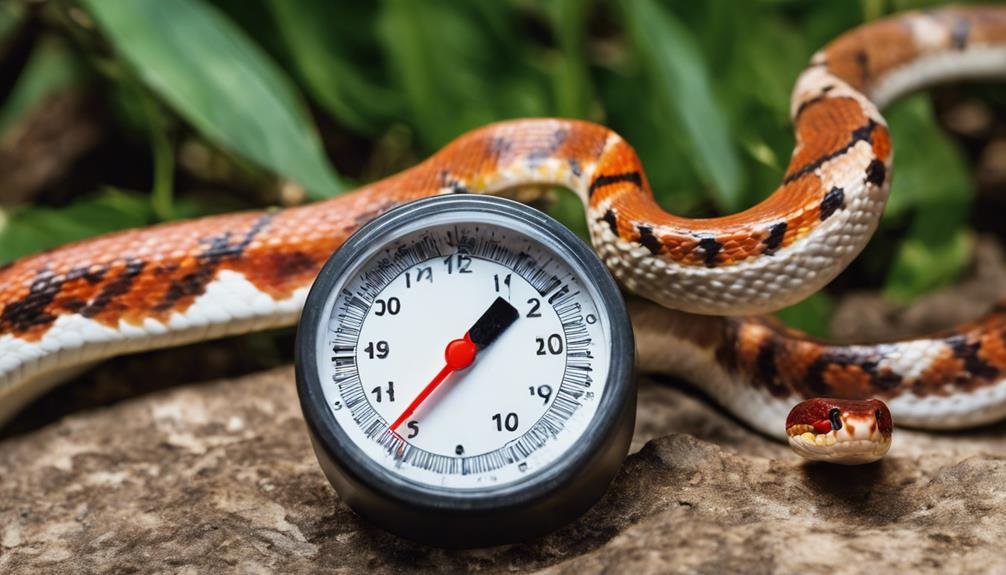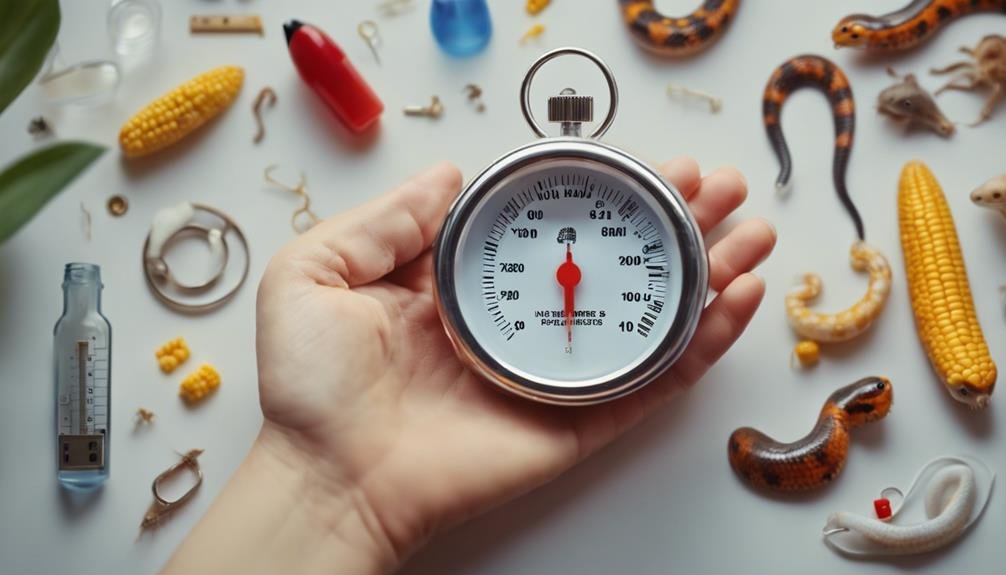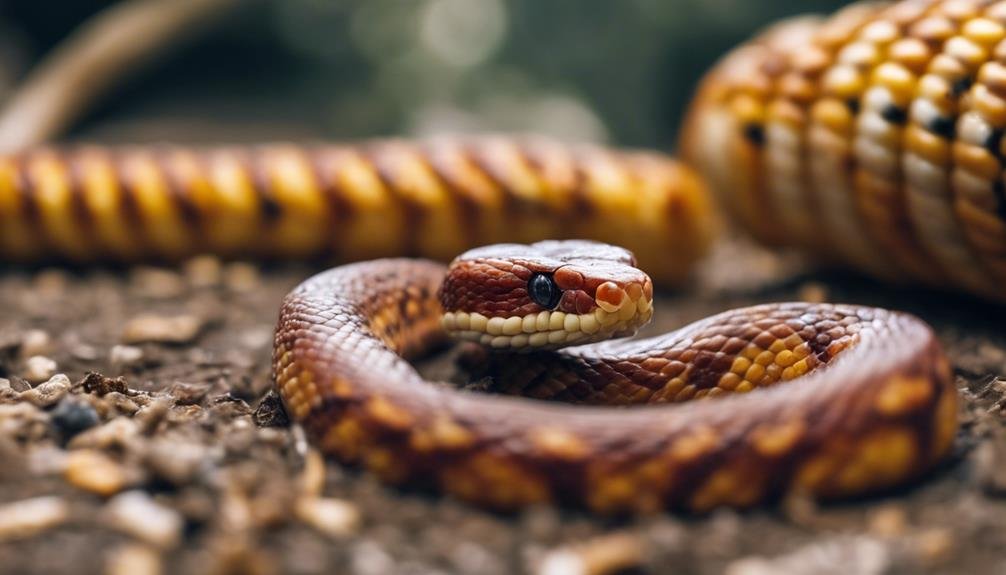If you've noticed your corn snake regurgitating its meals, you're likely dealing with an issue that's more complex than just an upset stomach. Whether it's due to incorrect temperatures, stress, inadequate humidity, or something more concerning like an underlying health problem, understanding the root cause is vital. You'll need to make sure the habitat is set up properly, with the right temperature and humidity, and consider the size and frequency of feedings. But what happens if these adjustments don't solve the problem? Exploring further into this topic reveals a range of solutions and preventive measures that could save you and your slithery friend from future distress.
Key Takeaways
- Regurgitation in corn snakes can be caused by stress, incorrect temperatures, and improper diet.
- Creating a stable environment with ideal temperature and humidity levels is crucial for prevention.
- Consult a veterinarian if regurgitation persists, indicating possible health issues or parasites.
- Gradually reintroduce small, properly warmed meals after a regurgitation episode, monitoring for further issues.
- Stress reduction, through minimized handling and providing hiding spots, supports recovery and overall health.
Identifying Regurgitation Causes
To effectively tackle regurgitation in corn snakes, one must first identify the underlying causes, ranging from environmental mismanagement to health issues. If your snake is experiencing regurgitation, it's critical to examine various aspects of their care and environment to pinpoint the problem.
Incorrect environmental temperatures play a significant role in regurgitation issues. Corn snakes require specific temperature gradients to digest their food properly. If the enclosure is too cold or too hot, it can interfere with digestion, leading to regurgitation. Similarly, stress from excessive handling or sudden changes in their environment can upset your snake's stomach, causing it to regurgitate its meal.
Humidity levels within the enclosure are another critical factor. Inadequate humidity can impact a corn snake's ability to digest properly. Paying attention to these environmental parameters is essential for their well-being.
Diet composition and feeding frequency also contribute to regurgitation. Feeding prey that's too large or feeding too frequently can overwhelm your snake's digestive system. Finally, the presence of parasites or other underlying health issues can be potent causes of regurgitation. Identifying and addressing these problems early is key to preventing further health complications in your corn snake.
Proper Habitat Setup
After pinpointing the causes of regurgitation, it's essential you set up your corn snake's habitat correctly to prevent further issues.
Ensuring the tank has ideal temperature ranges and manages humidity levels effectively can make a significant difference in your snake's digestive health and overall well-being.
Let's explore how to achieve the perfect environment for your corn snake, focusing on temperature and humidity management.
Ideal Temperature Ranges
Creating the perfect habitat for your corn snake involves setting up a temperature gradient, with a basking area heated to 88-92°F and a cooler zone at 78-80°F. This thermal gradient is key for body temperature regulation, essential in preventing digestion issues like regurgitation. Consistent monitoring and adjustment guarantee your snake can move between warmer basking spots and cooler areas, mimicking their natural environment and supporting overall health.
| Zone | Temperature Range | Importance |
|---|---|---|
| Basking | 88-92°F | Prevents regurgitation |
| Cooler | 78-80°F | Aids body temperature regulation |
| Overall | 78-92°F | Supports digestion |
| Monitoring | Consistent | Prevents health issues |
| Adjustment | As needed | Ensures ideal environment |
Humidity Level Management
Just as managing temperature ranges is key for your corn snake's digestion, properly monitoring humidity levels plays an essential role in their overall health. Keeping humidity levels between 40-60% is vital for corn snakes to avoid dehydration and difficulties during shedding.
To guarantee accuracy in monitoring, use a digital hygrometer in their enclosure. Providing a humid hide or moss can assist your snake in regulating their moisture needs effectively. This step in humidity management isn't just about comfort; it supports their overall health and helps in preventing respiratory issues.
Optimal Feeding Practices


To guarantee your corn snake's health and prevent regurgitation, it's important to adopt ideal feeding practices. Start by making sure you're hitting the mark with feeding intervals and prey size. This balance is essential to avoid overeating and subsequent regurgitation issues. You'll want to thaw prey items in the fridge overnight and warm them to 90-100°F before feeding. This temperature makes the prey more appealing and easier to digest for your snake.
Using plastic trays for feeding can greatly reduce the risk of your corn snake ingesting substrate, a common cause of regurgitation. This simple switch in your feeding practices safeguards your pet's health and ensures a cleaner eating environment.
Keep a close eye on your corn snake's feeding behavior. If you notice any odd behaviors or ongoing regurgitation issues, it's time to consult with veterinary care. A professional can provide guidance tailored to your snake's specific needs, ensuring that your feeding practices are supporting its health effectively.
Stress Reduction Techniques
Reducing stress in your corn snake's environment is essential for its well-being, and several straightforward techniques can make a significant difference. Stress reduction begins with providing a quiet, undisturbed environment that allows your corn snake to feel secure. Make sure that the area around the enclosure is free from loud noises and avoid sudden movements that could startle your snake.
Secure enclosures are vital for making your snake feel safe. Include proper hiding spots where it can retreat and feel protected. Maintaining consistent temperatures and humidity levels within the enclosure is also key to minimizing stress. These stable conditions mimic their natural habitat, helping your corn snake to thrive.
Implementing a regular feeding schedule and adhering to gentle handling practices are essential for stress reduction. These actions help establish a routine, making the snake's environment predictable and comfortable. Remember, routine establishment isn't just about what you do, but how consistently you do it.
Monitoring for Health Issues
Keeping a vigilant eye on your corn snake's health involves regularly monitoring for any signs of distress or illness. Essential husbandry practices are vital, and part of this responsibility includes close observation of your snake's behavior and physical condition. Start by looking for signs of stress, such as hiding more than usual or excessive pacing in the snake enclosure. These behaviors might indicate discomfort or an underlying health issue.
Additionally, check for any undigested or partially digested food, a clear sign that something might be amiss with your snake's digestive system. Monitoring your snake's weight and appetite for any changes is also crucial, as sudden shifts could signify health concerns that need addressing.
Keep track of the environmental conditions within the enclosure, ensuring the temperature and humidity levels are within the recommended range for corn snakes. Deviations from these conditions can lead to stress and health issues.
Lastly, be on the lookout for any signs of illness, including lethargy, respiratory issues, or mouth swelling. These illness symptoms require immediate attention. Regular health monitoring is key to catching and addressing any potential problems early, ensuring your corn snake remains healthy and happy.
Treatment Options
If your corn snake experiences regurgitation, the first step should be to let it rest, avoiding any handling to prevent further stress. It's important to provide a stress-free environment and follow proper husbandry practices as part of the treatment currently available. After a 2-week rest period, offering a small meal can help in the gradual reintroduction of food, which is essential for regurgitation prevention.
You should also monitor for symptoms during this time. If the issue persists or worsens, don't hesitate to seek veterinary help. A vet can provide specific advice and may suggest incorporating probiotics into your snake's diet to aid digestion and restore good stomach bacteria.
To make the treatment options clearer, here's a quick overview:
| Treatment Step | Details |
|---|---|
| Rest Period | 2 weeks with no handling to minimize stress. |
| Monitor for Symptoms | Seek veterinary help if regurgitation persists. |
| Gradual Reintroduction of Food | Start with a small meal after the rest period. |
| Probiotics | Can be beneficial for digestion. |
| Maintain Proper Husbandry | Ensure a stress-free environment for recovery. |
Following these steps can greatly assist in your corn snake's recovery from regurgitation.
Preventive Care Measures


While addressing regurgitation after it happens is important, taking steps to prevent it in the first place can save both you and your corn snake from stress. Good husbandry practices play a vital role in this. You've got to monitor and maintain the right temperature and humidity levels in the enclosure. If these are off, your snake could start having problems, including regurgitation.
Handling your corn snake carefully, especially after feeding, helps minimize stress, which can also lead to regurgitation. It's all about keeping them calm and comfortable. Overfeeding or offering prey that's too large can be a big problem too. Stick to a balanced and appropriate diet to keep your snake healthy and regurgitation at bay.
Regular check-ups with a reptile veterinarian are essential. They can catch any potential health issues early on before they lead to serious problems like regurgitation. And don't forget about hygiene. A clean enclosure is a healthy enclosure. Make sure you're cleaning it regularly to prevent contamination and other potential causes of regurgitation.
When to Consult a Veterinarian
Recognizing the signs that your corn snake needs veterinary care is essential for its health and well-being. Persistent issues like regurgitation can signal underlying health problems that require immediate attention. It's vital to know when a visit to the vet is necessary to guarantee the well-being of your beloved pet.
If you notice any of the following symptoms, it's time to consult a reptile veterinarian:
- Persistent regurgitation, dehydration, or severe weight loss
- Abnormal behavior such as lethargy, loss of appetite, or respiratory issues like wheezing or unusual noises
- Physical signs of distress including discoloration or swelling around the mouth
These symptoms indicate that your corn snake could be suffering from serious health issues that need professional diagnosis and treatment. Dehydration and weight loss can quickly become life-threatening, while respiratory issues and abnormal behavior can signal infections or other serious conditions.
Don't wait until it's too late. A timely visit to the vet can make a significant difference in your corn snake's health. Remember, when in doubt, it's always better to err on the side of caution and get a professional opinion. Your proactive approach could save your snake from further discomfort or potential complications.
Can Reproductive Issues in Corn Snakes Lead to Regurgitation?
Reproductive issues in corn snakes, such as complications during the corn snake mating process, can potentially lead to regurgitation. This could be caused by stress or physical discomfort related to breeding. It’s important for snake owners to monitor their pets closely during the mating period to ensure their well-being.
Conclusion
To sum up, if your corn snake's regurgitating, it's important to pinpoint the cause, from improper habitat conditions to stress or health issues. Make sure their environment's right, with correct temperatures and humidity, and stick to ideal feeding routines.
Reduce stress and keep an eye out for any signs of health problems. Treatment might include probiotics or a vet visit for serious concerns. By practicing good husbandry and seeking timely veterinary care, you'll greatly reduce the chances of regurgitation issues in your corn snake.


